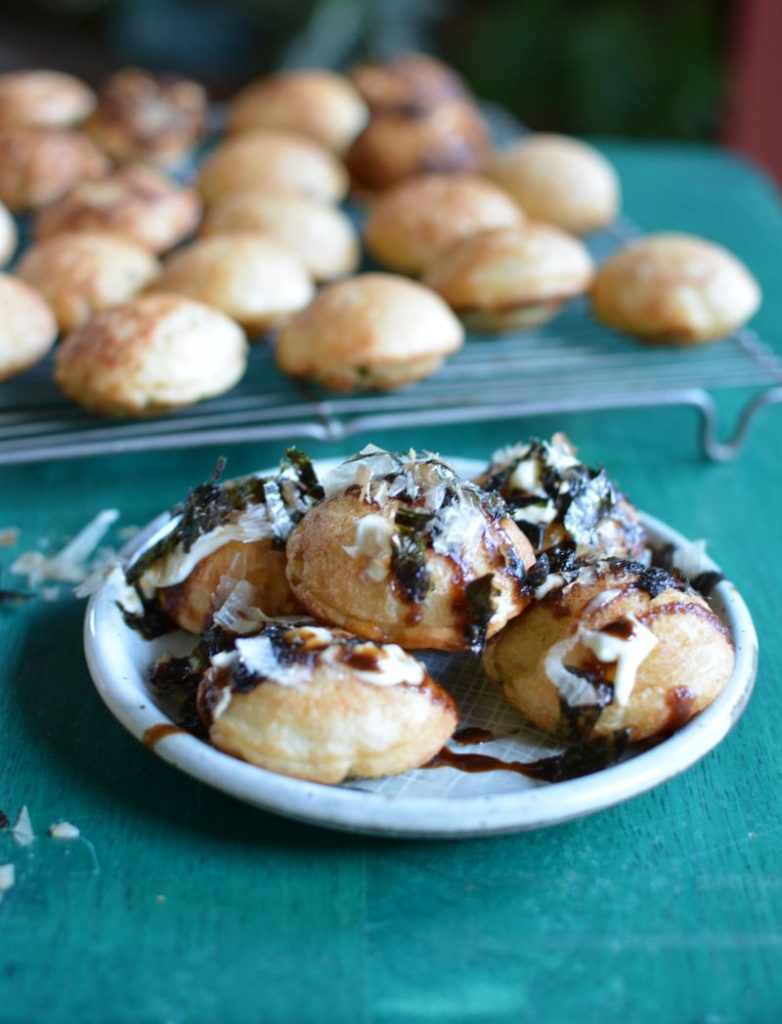
Some of my better ideas come early in the morning, when I first wake up. This week, I had a hunch that I could make incredible gluten-free takoyaki dumpling balls. What are takoyaki? They’re a super popular Japanese street food dumpling (second to gyoza!) that are often filled with chunks of cooked octopus. Takoyaki are fashioned from a batter seasoned with piscine, smoky dashi broth and are cooked into a round balls in what else but a takoyaki pan.
My homemade ones look more like Stewie Griffin's head or funny footballs but they still taste great! Actually, there's a higher ratio of filling to batter, which I like. Sometimes perfect spheres of takoyaki can be heavy.
Takoyaki are traditionally made with a low-protein wheat flour and eaten hot and delicately crisp from the pan, garnished with drizzles of tangy salty tonkatsu sauce, umami mayonnaise, nori, and katsuobushi (shaved, dried bonito flakes). The little balls are quite a mouthful but they’re not hard to make. However, the traditional approach yields a crisp exterior that softens fast. Was there a simple workaround?
Takoyaki equipment
I busted out my old cast iron pans – the pancake puff pan is what you’d use for aebelskiver. The other pan has a flat bottom and used for Vietnamese banh khot, which are like super fried crispy version of pudding-ish khanom krok in Thai, Lao and Khmer cuisines. A takoyaki street food vendor can handle making a lot of them at a time but I’m fine with the one pancake puff pan. You can use a dedicated takoyaki pan, too.
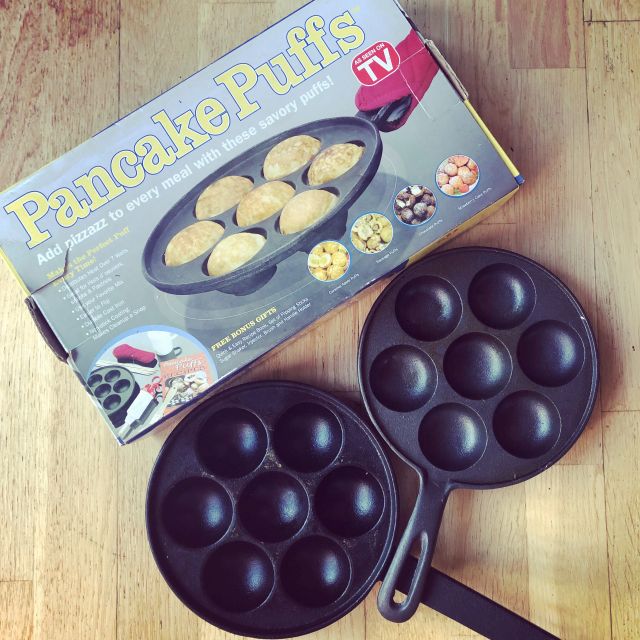
Options for Takoyaki ingredients
As for the batter, I switched from cake flour to Bob’s Red Mill’s 1-to-1 gluten-free all-purpose flour, which can be used as a straight sub for regular AP flour. I’ve blended my own flour blends for gluten-free pot stickers and it can be very tricky and expensive. For these takoyaki, I wondered if I could saunter into a supermarket and use an off-the-shelf gluten-free all-purpose flour. BRM's flour has worked well for banana bread and waffles. More importantly, Bob’s flour is made from rice flour and starches, so I figure I could fry them a little crispier than the cake flour ones. The bonus of that substitution is creating gluten-free takoyaki!
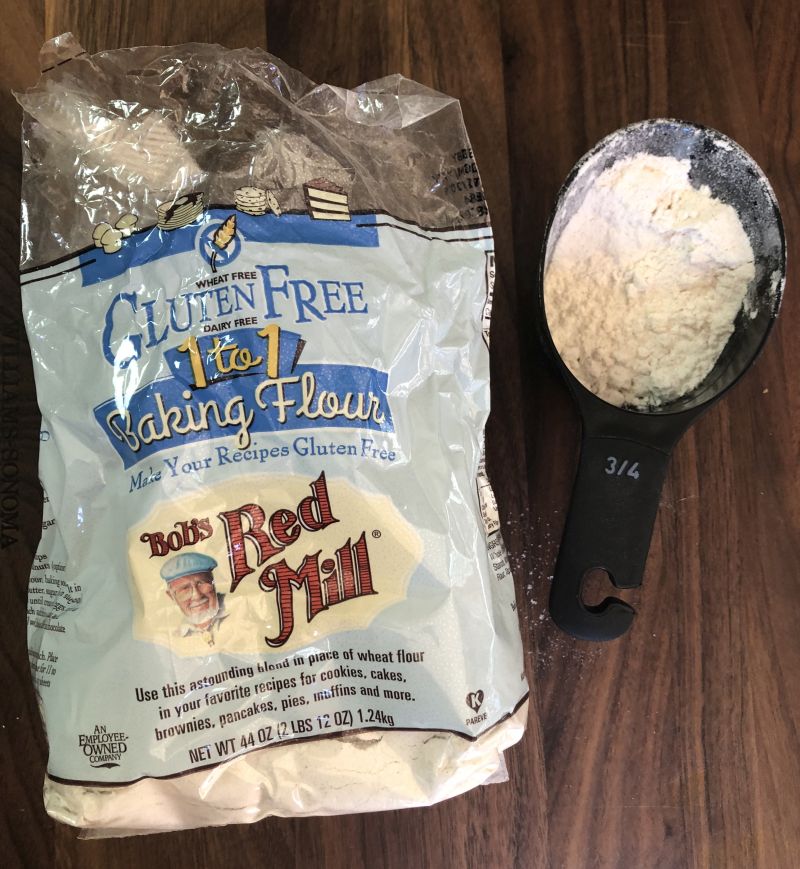
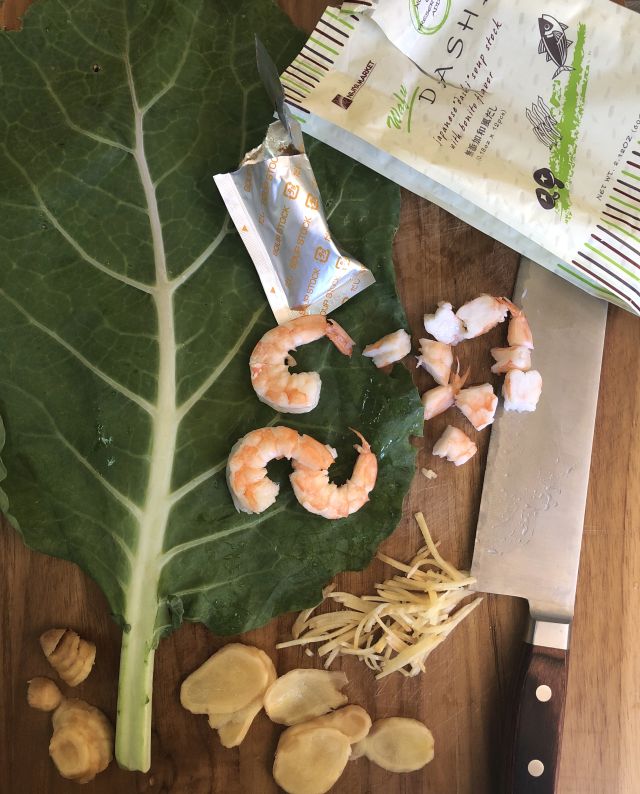
The filling for takoyaki is minimal. Instead of octopus, I like cooked shrimp. In the back of my fridge, I found a jar of homemade pickled ginger. The produce bin had some collards and green onion, which added color and touch of flavor.
If you don’t have instant dashi powder, use Better-than-Bouillon, though you’ll be missing out on the smokiness of dashi. You could omit the dashi powder and instead of water, use homemade dashi, canned broth, or even try pho broth! There’s license to be creative when making takoyaki.
How to make takoyaki
It’s just like making pancakes. The first ones are not perfect. Be patient and listen for a gentle hiss and little bubbles. Fill the wells fast because you need to pay attention to turning them. Skewers are your tools because they can dig right between the takoyaki and the pan.
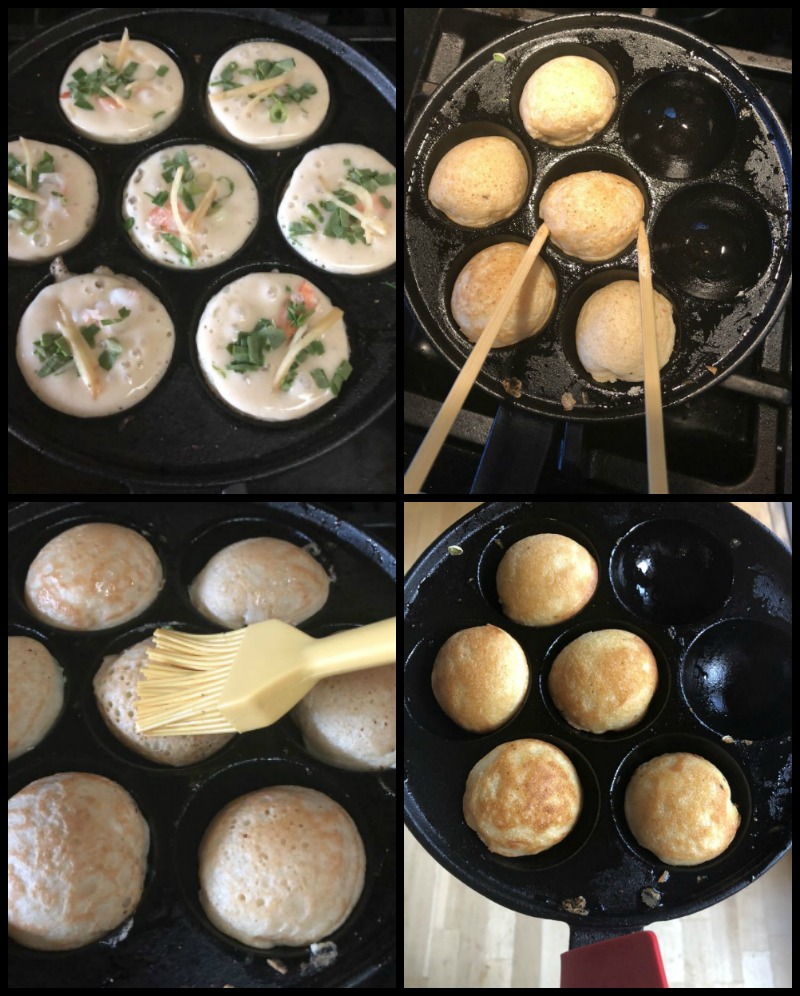
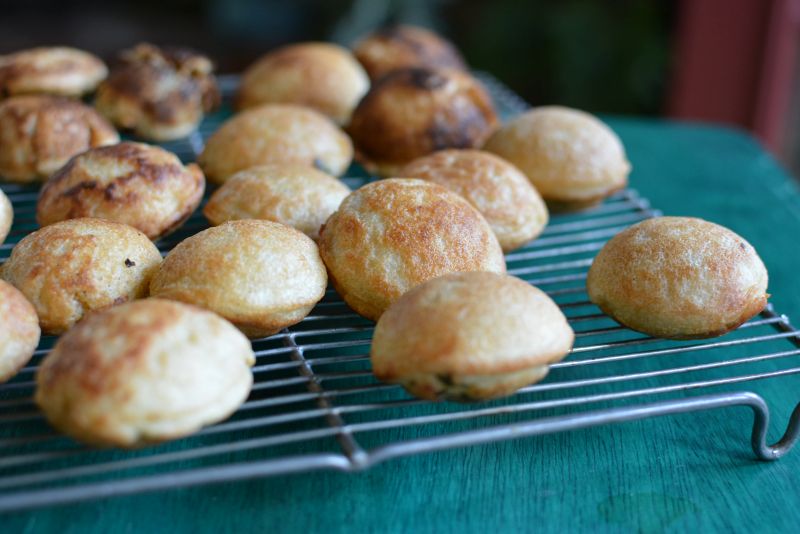
After the first turn, the batter is set so you can keep turning them. The great thing about the gluten-free takoyaki batter is I could lightly oil and fry them up to a crispness that held longer than usual with the regular wheat flour. That said, the takoyaki are still best enjoyed soon after they’re made. Refrigerating and reheating them returns them to 85% good. Enjoy!
Related posts:
- Umami Mayo recipe
- Pickled Japanese Ginger recipe
- How to make Gluten-Free Pot Stickers
- Original Takoyaki Recipe (from 2009, on Asian Dumpling Tips)
Gluten-Free Takoyaki
Yield 16 dumplings
Bob’s Red Mill gluten-free all-purpose flour is sold at natural food grocers and some regular grocers. You can use it like regular wheat AP flour without having to add xanthan gum.
Ingredients
Batter
- 6 ounces Bob’s Red Mill 1-to-1 Gluten-Free all-purpose flour, or another brand of your liking
- 1 ¾ teaspoons baking powder
- Scant ½ teaspoon salt
- 1 ½ teaspoons sugar
- 1 ½ teaspoons instant dashi powder
- 1 large egg
- 1 ⅓ cups water
Filling and cooking
- 3 extra-large cooked shrimp, cut into peanut-size pieces (⅓ cup)
- 2 tablespoons finely chopped green onion, white and green parts
- 2 tablespoons finely chopped or matchstick-cut pickled ginger, store bought or homemade
- 2 tablespoons finely chopped kale or green cabbage (omit hard center spine)
- 2 to 3 tablespoon canola oil or other neutral oil
Garnishes
- About 3 tablespoons Japanese tonkatsu sauce, Worcestershire sauce, or Chinese black vinegar
- About 3 tablespoons mayonnaise, regular or umami mayo (optional)
- 1 ½ tablespoons aonori (ground dried seaweed), or 1 full-size sheet toasted nori (seaweed), cut into short, thin pieces
- ½ cup loosely packed Japanese dried bonito flakes (katsuo-bushi)
Instructions
- To make the batter, combine the flour, baking powder, salt, sugar, and dashi powder in a bowl. Make a hole in the center. Whisk together the egg and water, then whisk into the dry ingredients to form a smooth batter. Transfer to a measuring cup. Set aside to bloom for at least 15 minutes (or cover with plastic and leave at room temperature for as long as 2 hours).
- Have the filling ingredients ready near the stove, along with the batter. Make sure the garnishes are ready too.
- Heat the pancake puff, aebelskiver, or takoyaki pan over medium heat. Brush a light coating of oil in each well. Aim for a moderately warm pan as if you’re making pancakes. Too hot of pan will form craters on the surface and you want a smooth finish on these dumplings.
- When the pan is sufficiently hot, pour batter into the pan to just shy of the rim. If your burner has hot spots, fill the wells above those hot spots last. If anything, there should be just a light sizzle when the batter hits the pan. Lower the heat if the sizzling is loud as that’s a sign that the pan is too hot.
- Add 1 or 2 pieces of shrimp and generous pinches of scallion, ginger, and cabbage to each well. The batter level will rise a tad. Then wait for about 60 seconds until the edges have begun to set or small bubbles have formed at the rim. When that happens, use two skewers to loosen each dumpling around the top edge and flip it over. Expect the dumplings to be pale in color at this stage.
- Don’t fret about doing it neatly. Aim to flip it over when there’s still enough loose batter to form a round underside; some may look like Pacman but that’s fine. After about 1 minute, the batter should have set on the other side and you can tuck the dumpling into the well to cook evenly into a nice round shape.
- Cook for about 1 minute, brush with a little oil, then turn and rotate. Repeat to cook this way for about 5 minutes, until golden and crisp. Use chopsticks or the skewers to transfer (stab the dumpling if you must) the dumplings to rack. Meanwhile, oil and repeat the cooking to make more takoyaki dumplings.
- If you like, before serving, reheat or recrisp any early batches of takoyaki. Heat them in the pan with a tiny bit of oil for 1 to 2 minutes. When satisfied, present on a plate, drizzle the tonkatsu sauce and squeeze (or pipe) mayonnaise atop the dumplings. Sprinkle with seaweed and finish with the bonito flakes. Eat with forks, chopsticks, or if you want to mimic the street food experience, use skewers.
Courses snack
Cuisine japanese













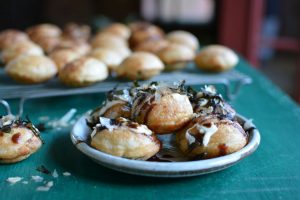




Kristine Hoover says
I'm giving aebelskiver pans for Christmas this year + a cookbook I like & a few on my recipes. When I lived in Japan, I was surprised & delighted to find takoyaki! Wanted to send a few Asian recipes & this is so timely. Thank you!
These are really fun to make. I also use chopsticks to turn mine; my elderly Scandinavian neighbor was a bit shocked by this since everyone she knows uses knitting needles.
Ingebretsen's here in Minneapolis sells at least 4 (!) kinds of aebelskiver pans & I'm sure they do mail-order if people are having trouble finding them.
Andrea Nguyen says
Knitting needles??!! Brilliant. They're long, poke and turn, and you can wash them when you're done. Thanks for the Minneapolis tip. I have keen interest in visiting some day.